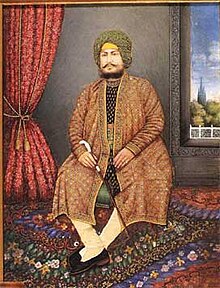Town in Punjab, India
| Bagrian | |
|---|---|
| Town | |
  | |
| Coordinates: 30°25′52″N 76°02′12″E / 30.431188°N 76.036542°E / 30.431188; 76.036542 | |
| Country | |
| State | Punjab |
| District | Sangrur |
| Languages | |
| • Official | Punjabi |
| Time zone | UTC+5:30 (IST) |
| PIN | 148018 |
Bagrian is a village located in Sangrur District, in Punjab, India which has a significant place in Sikh history. Now Called it by Bagrian Haveli name.
The House of Bagrian owned much of the land and the haveli in the village, where certain important artifacts that belonged to the Sikh Gurus are kept. The Bhai Sahibs of Bagrian also run a langar that serves free food to everyone who goes there. The First Punjabi film Long Da Lishkara (1986) was filmed in this village. After that Tera Mera Ki Rishta (2009), Ekam: Son of Soil (2010), Son of Sardaar (2012), Yamla Pagla Deewana, as well as the serial Ek Veer Ki Ardaas...Veera in 2012.
History

Situated on the Malerkotla-Nabha road, Bagrian lies about 18km southeast of Malerkotla. Though now in Malerkotla Tehsil, it was not a part of the Malerkotla Princely State but was ruled by the British Colonial authorities. Haveli was made by Guddar Singh. The village had been given to him by Adina Beg the Governor of Jalandhar city at the time, in appreciation of Bhai Guddar Singh's piety.
The Bhais still run a langar (free kitchen) daily. This tradition of langar was started from the time of Guru Hargobind, the Sixth Sikh Guru. The village also had a wide expanse of green areas.
The Bagrian state is a continuation of a tradition of religious service from the times of Bhai Rup Chand, who was blessed by the Sixth Guru in 1634.
References
- "Census of India Search details". censusindia.gov.in. Retrieved 10 May 2015.
- 1884, Thomas Gordon Walker, Final report on the revision of settlement, 1878-83, of the Ludhiána district in the Panjáb, p. 61,
- There are two or three famous Langars or almshouses, well known throughout the country. That of Bagrián lies 40 miles south of Ludhiána.
- 1987, William Hewat MacLeod, Karine Schomer, The Sants: studies in a devotional tradition of India, Motilal Banarsidass, ISBN 8120802772, p. 261,
- Bagrian is in Ludhiana District , seven and one half miles north-west of Nabha .
- 1996, Joseph Davey Cunningham, H.L.O. Garrett, History of the Sikhs from the Origin of the Nation to the Battles of the Sutlej, Asian Educational Services, ISBN 8120609506, p. 62,
This article about a location in the Indian state of Punjab is a stub. You can help Misplaced Pages by expanding it. |
| Populated places in Sangrur district | |
|---|---|
| Cities and towns | |
| Villages and settlements | |